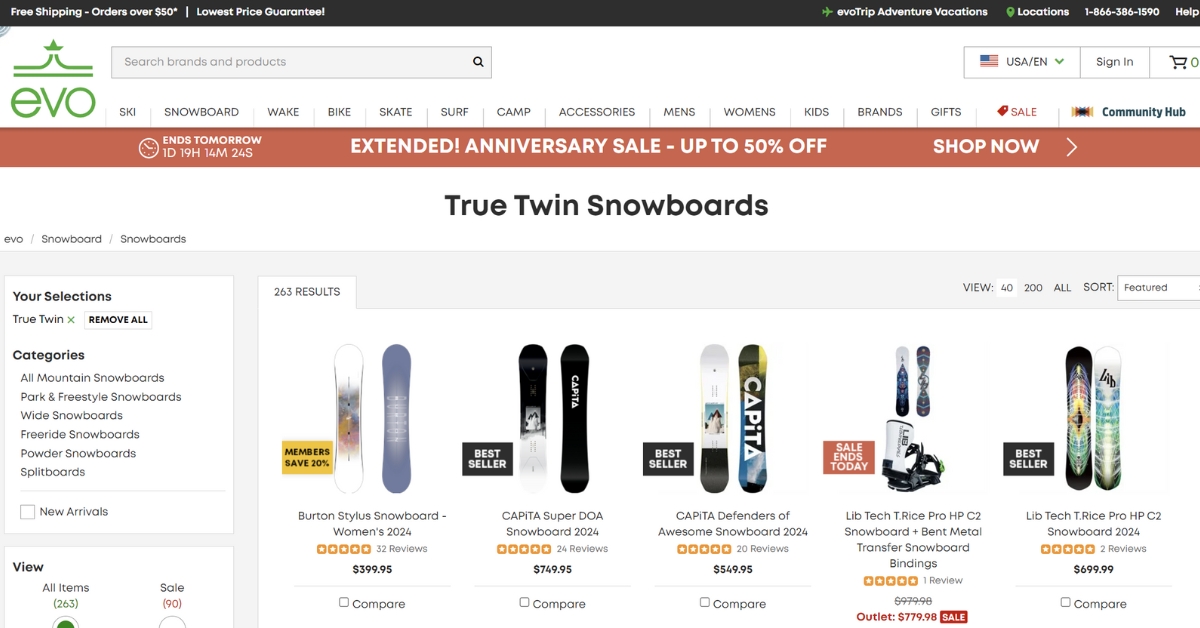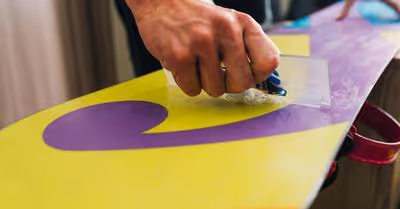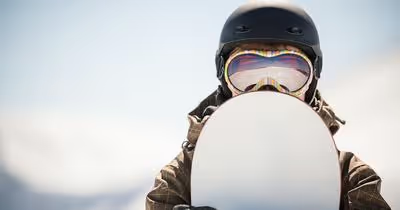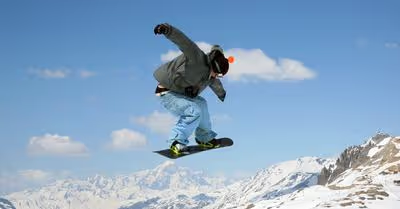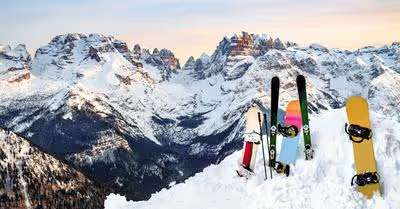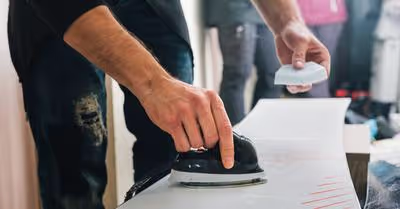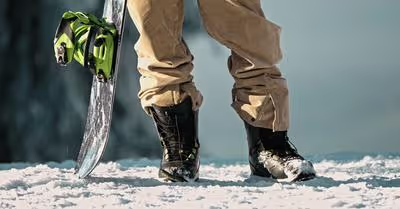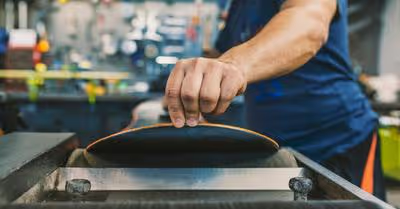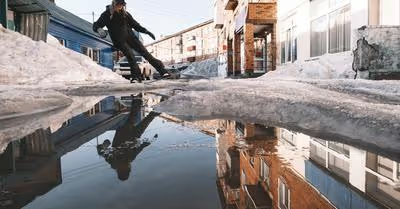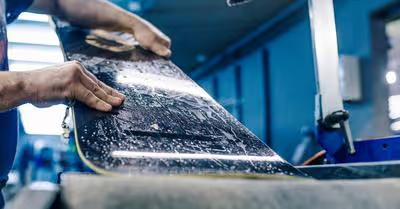Table of Contents
Best Snowboard Shape for Beginners
For beginners, one of the most important factors to consider when starting out is choosing the appropriate snowboard shape. The shape of a wider board not only influences its performance on different types of terrain but also plays a crucial role in helping novices gain confidence and control on the slopes.
There are various snowboard shapes designed for specific riding styles and conditions, with some being more suitable for beginners than others. True Twin, Directional Twin, and Directional shapes offer various levels of versatility and performance.
Similarly, Flat, Rocker and other camber profiles can have a significant impact on a snowboard's handling and stability. Choosing a snowboard shape that complements a beginner's skill level and aspirations can make all the difference in their progression and overall enjoyment of the sport.
This table highlights the features of the best snowboard shapes for beginners.
1. True Twin Board
True Twin Board
The True Twin snowboard shape is popular among beginners due to its symmetrical design and versatile performance. This section covers the main features of a True Twin snowboard, including symmetry, nose and tail shape, flex pattern, base profile, and edge contact points.
Symmetry
A True Twin snowboard is designed with symmetrical dimensions and shape from nose to tail. This means that both ends of the freestyle board are identical, and the bindings are centered, allowing pack riders to perform the switch (riding with the opposite foot forward) with ease.
This feature is especially important for freestyle riders who frequently need to change their stance and perform tricks.
Nose and Tail Shape
The nose and tail shape of a True Twin snowboard are identical, which creates a balanced ride and allows for seamless transitions when riding the switch. The similar shape at both ends also provides consistency during jumps and landings, making it easier for beginners to grasp fundamental techniques.
Flex Pattern
True Twin snowboards have a symmetrical flex pattern throughout the freestyle board. This means that the flex at the nose and tail is consistent, offering predictable performance for riders. This even flex makes it easier for beginners to control their snowboard and execute turns smoothly.
Base Profile
The base profile of a True Twin snowboard is designed to offer optimal performance in a variety of conditions. These freeride boards often feature a hybrid camber design, combining elements of both camber and rocker profiles. This allows for a versatile ride that provides stability on groomed trails and responsiveness while riding in the park.
Edge Contact Points
The edge contact points on a True Twin snowboard are symmetrical and evenly spaced, allowing for a balanced level of grip and control while carving. This feature prevents the all-mountain board from catching edges unexpectedly and provides a predictable, stable ride, which is ideal for beginner snowboarders.
The True Twin shape is an excellent choice for beginner riders due to its symmetrical design, consistent flex pattern, versatile base profile, and predictable edge contact points. This snowboard shape is especially well-suited for freestyle riding and those looking to learn and perfect riding switch, as shown in this video.
2. Directional Twin
The directional twin snowboard shape offers a balanced and versatile ride for beginners. Its hybrid design and medium soft flex make it an ideal choice for those who want to explore different riding styles and progress their skills on the mountain.
Symmetry
The Directional Twin snowboard shape is a versatile choice for beginner snowboarders. It possesses a slightly asymmetrical design, which combines the features of both true twin and directional shapes.
This hybrid shape allows beginners to experiment with different riding styles while maintaining a sense of stability and predictability on the slopes. Generally speaking, this shape is suitable for all-mountain and freeriding enthusiasts, as well as those who want to practice riding switch.
Nose and Tail Shape
The hallmark of a directional twin snowboard is its unique nose and tail shape. The nose is typically longer and higher, while the tail is shorter and lower. This design helps to improve float in powder conditions and provides a more stable ride when navigating through varied terrain.
Despite these differences, the overall maneuverability of a directional twin shape remains excellent, making it a good choice for beginner snowboarders.
Flex Pattern
Directional twin snowboards tend to have a medium flex, which offers a balance between the softer flex of freestyle boards and the stiffer flex found on freeride boards. This flex rating is suitable for a wide range of riding styles, from carving turns to jibbing in the park.
The medium flex is also forgiving enough for beginners, allowing them to learn new tricks and perfect their technique without the added challenge of stiff flex boards. Check out its pattern in this video.
Base Profile
The base profile of a directional twin snowboard typically features a hybrid camber. This design combines elements of both camber and rocker profiles, with a camber between the bindings and a rocker towards the nose and tail.
The camber section offers stability, edge hold, and power through turns, while the rocker sections help to improve float in powder and provide a catch-free feel for easier turning and maneuvering.
Edge Contact Points
The edge contact points on a directional twin snowboard help to provide a consistent and stable grip on the snow. These points are strategically placed along the edge to improve control while maintaining a smooth ride.
Riding a switch is also possible on a directional twin, although it may be slightly more challenging compared to a true twin shape due to the asymmetry in the nose and tail.
3. Directional
Directional snowboards are designed for riders who primarily want to ride downhill. These freeride boards provide a steady and stable ride, making them an excellent choice for beginners. Directional boards are built with features that help with carving and powder riding while still offering versatility for different riding styles.
Symmetry
Unlike freestyle boards, directional snowboards are typically asymmetrical, meaning they have a distinct front (nose) and rear (tail) end. They are designed to be ridden primarily in one direction, which allows for better control when riding downhill or through powder.
An asymmetrical design contributes to the snowboard's performance in various situations like freeriding, and it's essential for beginners to familiarize themselves with the directional shape of their shorter board.
Nose and Tail Shape
The nose and tail shapes of a directional snowboard are different, which helps improve performance in specific conditions.
A longer and wider nose is helpful in floating on top of powder snow, whereas a shorter and narrower tail allows for better carving and more effortless turns. This nose-to-tail differential helps maintain stability while riding downhill, especially for those just starting to learn snowboarding.
Flex Pattern
Directional boards typically have a softer flex pattern in the front and a stiffer flex towards the back. This design leads to better control and stability when learning how to ride, as it allows for more natural transitions between turns.
A medium soft flex in the nose and medium flex in the tail of directional boards is ideal for beginners looking for a comfortable and predictable ride.
Base Profile
The base profile of a directional beginner board often features a hybrid camber, combining the elements of both camber and rocker profiles. A continuous rocker profile is ideal for beginner snowboards, as it provides a catch-free and easy-to-turn ride.
However, hybrid camber profiles offer the best of both worlds with the stability of camber underfoot and the catch-free nature of rocker in the nose and tail.
Edge Contact Points
The edge contact points of a directional beginner board are strategically placed to help beginners maintain stability and control. They provide a solid edge grip during turns and help riders initiate turns more quickly and smoothly. For beginners, selecting a beginner board with effective edge contact points is necessary for a safe and enjoyable learning experience.
4. Flat
When it comes to choosing the best snowboard shape for beginners, one option worth considering is a flat profile.
Symmetry
Flat snowboards, also known as true twin beginner boards, are typically symmetrical in shape. This means the nose and tail are identical, and the board's width is consistent throughout. This symmetry allows beginners to ride the switch more easily as the all-mountain board behaves the same in both directions.
Nose and Tail Shape
The nose and tail shape of a flat snowboard is either rounded or slightly pointed, resulting in a board that can float over powder and make it easier to initiate turns. This is beneficial for beginners as it offers a more forgiving and stable ride in various snow conditions.
Soft Flex Pattern
Beginner boards, like flat boards, often feature a soft to medium flex pattern. This softer flex pattern provides stability and control while allowing for easier turn initiation. Stiff flex boards, in contrast, can be more challenging for beginners due to their higher speed and less forgiving nature.
Base Profile
Flat snowboards have a flat base profile, providing more edge contact with the snow compared to hybrid rocker profiles. This increased edge contact helps beginners with stability and control while they are learning to turn and control their snowboard.
Edge Contact Points
Edge contact points on a flat snowboard are located at the widest points of the nose and tail. These points aid in grip and edge control, which is crucial for beginners as they develop their snowboarding skills. This helps prevent catching edges and can result in a smoother ride with fewer falls.
Flat snowboards offer a well-rounded option for beginner riders who want a shorter board that is easy to control and provides a stable ride. They are an excellent choice, particularly for those just learning to snowboard and looking to build their confidence on the mountain. See its functionality in this video.
5. Rocker
The rocker, also known as reverse camber, is a powder snowboard profile that curves upwards toward the nose and tail. This shape is ideal for beginners because it provides a more forgiving and catch-free ride, perfect for learning the basics of snowboarding.
Symmetry
A true twin shape is a symmetrical snowboard with a centered stance, which means the nose and tail are identical in shape and size. This is optimal for beginners who want to learn how to ride switch, as the board will feel the same riding style in both directions.
Nose and Tail Shape
For a beginner snowboard, a hybrid rocker profile is recommended, as it combines rocker and camber sections to provide a catch-free ride with ample stability. The rocker sections in the nose and tail help with turn initiation and maneuverability, while the camber underfoot adds pop and edge hold.
Flex Pattern
A softer flex is more suitable for beginner snowboarders as it allows for easier turn initiation and more forgiving landings. A soft to medium flex is generally found in freestyle boards and all-mountain boards, which are excellent choices for those starting their snowboarding journey.
Base Profile
The continuous rocker profile ensures a catch-free ride, as there is no camber or rocker between the feet. This flat-to-rocker profile results in a stable and predictable shorter board that is great for beginners and intermediate riders looking for an easy-to-ride snowboard that can progress with their skills.
Edge Contact Points
Edge contact points are crucial when it comes to the snowboard's performance on various terrains and snow conditions. Freeride snowboards with continuous rocker profiles have fewer edge contact points, making it easier for beginners to initiate turns without catching an edge.
Understanding the Science Behind the Snowboarding Fun
When it comes to snowboarding, it's not all just about carving fresh tracks in the snow or catching big air off a jump. There's some serious science at play, especially when it comes to the shape of your snowboard.
1. Camber and Rocker
Ever noticed how some snowboards have a gentle arch (camber) while others seem flat (rocker)? These design choices have a big impact. Camber provides more contact with the snow, offering stability and precision, which is great for beginners.
On the other hand, rocker boards lift the tips and tails, making turning easier and enhancing float in powder.
2. Edge Control
The edge of your size board is your best friend on the slopes. Depending on the shape, it can bite into the snow for tighter turns (like with directional boards) or offer a bit more forgiveness for novice riders (such as a twin shape).
3. Snowboard Length Matters
The Snowboard length of your snowboard is closely linked to its shape. Longer boards often offer better stability at high speeds and float in deep powder, ideal for freeriding. Shorter boards are nimbler, perfect for tricks and park riding. Beginners usually find snowboard-length boards a great balance.
4. Sidecut Radius
The curvature of the snowboard's edges, known as the sidecut radius, plays a role in how it turns. Smaller radii make for quicker turns, while larger radii provide smoother, more drawn-out turns. Choose the radius that suits your riding style and the terrain you prefer.
5. Flex and Response
The flexibility of your snowboard, which varies with its shape, affects how it responds to your movements. Stiffer boards (common in directional shapes) offer more stability at speed and control on groomed runs.
Softer boards (often seen in freestyle and twin shapes) are more forgiving and maneuverable, great for learning tricks.
Recent Articles



